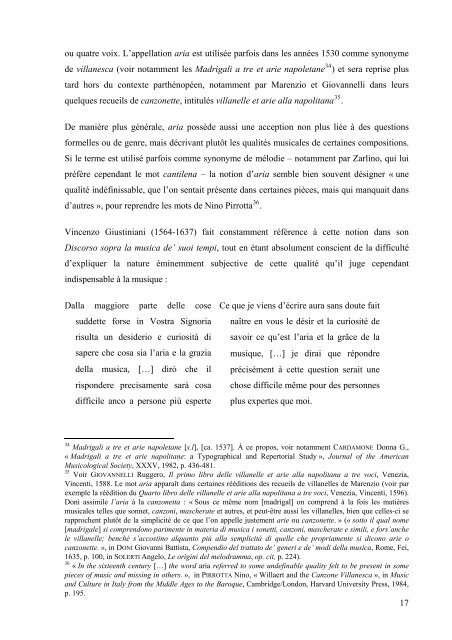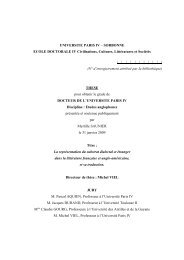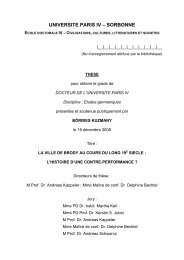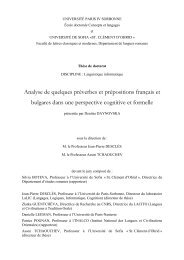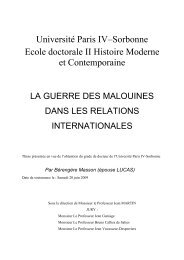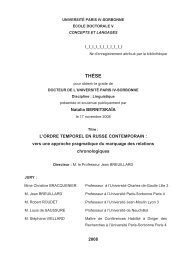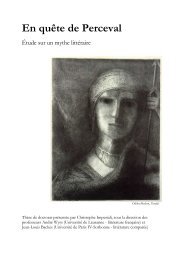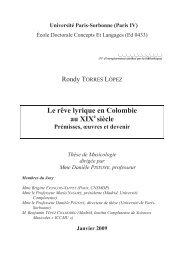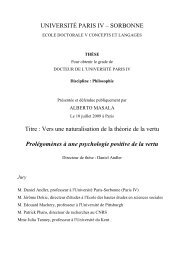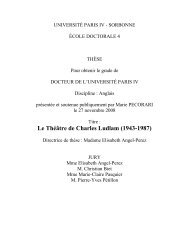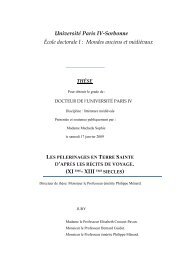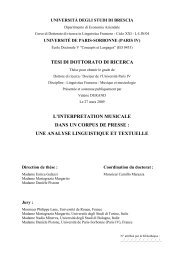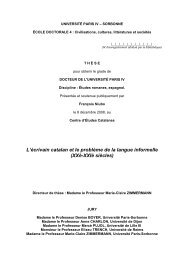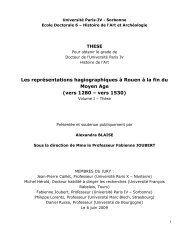- Page 1 and 2: Université Paris Sorbonne (Paris I
- Page 3 and 4: Nota bene : Les abréviations suiva
- Page 5 and 6: l’origine du compositeur, la date
- Page 7 and 8: une quinzaine de pièces instrument
- Page 9 and 10: table 1 : chronologie des recueils
- Page 11 and 12: Outre ces deux recueils, il m’a s
- Page 13 and 14: table 2 : état de conservation et
- Page 15: omaines pour deux personnalités de
- Page 19 and 20: dans la dédicace du Secondo libro
- Page 21 and 22: Le terme artificio semble correspon
- Page 23 and 24: più diletti universalmente quando
- Page 25 and 26: nuovo diletto, tanto quelle da cant
- Page 27 and 28: La période prise en considération
- Page 29 and 30: Giovannelli and The Madrigal in Rom
- Page 31 and 32: d’autres aspects de la lecture mu
- Page 33 and 34: congrégation qui joua vraisemblabl
- Page 35 and 36: Secondo libro de madrigaletti et na
- Page 37 and 38: occasione non mi partirei già di q
- Page 39 and 40: moins de vingt-huit recueils, soit
- Page 41 and 42: Lorsque Macque publia le recueil de
- Page 43 and 44: entretenait aussi à sa cour les de
- Page 45 and 46: All’Illustrissimo Signor Camillo
- Page 47 and 48: Ringratio Vostra Signoria per infin
- Page 49 and 50: L’intérêt que put revêtir ce s
- Page 51 and 52: dichi prima parte et seconda parte,
- Page 53 and 54: e foco, e ’l foco? fiamme e foco!
- Page 55 and 56: troppo ristretto è ’l laccio e l
- Page 57 and 58: Si quelques textes des Madrigaletti
- Page 59 and 60: et celles de Rossi (1589), Orologio
- Page 61 and 62: ella, rendete? Donna leggiadra e vo
- Page 63 and 64: more, mai pietà gran beltà! non r
- Page 65 and 66: 153 Non so che far mi deggia, c il
- Page 67 and 68:
né sento le dolcissime parole che
- Page 69 and 70:
Ite rime dolenti, trovate il mio be
- Page 71 and 72:
core, nel vero amante e disse, sosp
- Page 73 and 74:
Sur la base de l’étude et la com
- Page 75 and 76:
15.Se del mio mal non curi 1 x 16.A
- Page 77 and 78:
fuggire 14.Quando sorge l'aurora 7
- Page 79 and 80:
A A B B AA BB comme dans les exempl
- Page 81 and 82:
Ill. 2 : ROSSI Salomone, Primo libr
- Page 83 and 84:
de même que les deux textes repris
- Page 85 and 86:
Ce type de répétition n’est pas
- Page 87 and 88:
Vedi per te ch’io moro Oimè Oim
- Page 89 and 90:
de cori spezzati entre les voix - r
- Page 91 and 92:
automatiquement à un certain nivea
- Page 93 and 94:
Las invenciones de los madrigales h
- Page 96:
96 exemple musical 3b : Vorrei nel
- Page 99 and 100:
voix 189 , fait figure de précurse
- Page 101 and 102:
Dans quelques cas, le modèle peut
- Page 103 and 104:
Rythme C Le troisième modèle ryth
- Page 105 and 106:
Modèles prosodiques Ces quatre mod
- Page 107 and 108:
table 12 : liste exhaustive des ver
- Page 109 and 110:
ma stringimi ch’al mormorar e d
- Page 111 and 112:
Il s’agit en général plus de re
- Page 113 and 114:
la logique de l’harmonie tonale.
- Page 115 and 116:
4. Mentre al mio chiaro e vivo sol
- Page 117 and 118:
Contrepoint et « ancrage » harmon
- Page 119 and 120:
voi 216 (l’un des rares numéro
- Page 121 and 122:
Séquence b exemple musical 20a : s
- Page 123 and 124:
Autres séquences harmoniques Il es
- Page 125 and 126:
Raisonner par petites séquences a
- Page 127 and 128:
Tentons maintenant de relier ensemb
- Page 129 and 130:
Ce schéma synoptique met en évide
- Page 131 and 132:
Concentration des figures Macque, d
- Page 133 and 134:
Macque décide de s’attarder sur
- Page 135 and 136:
texte-musique, préférant les figu
- Page 137 and 138:
séquences harmoniques. Complexifie
- Page 139 and 140:
table 23b : intonations du mot fiam
- Page 141 and 142:
table 23c (suite) Parmi tous les re
- Page 143 and 144:
liberali, che danno à gli huomini
- Page 145 and 146:
DEUXIEME PARTIE - IL PRIMO LIBRO DE
- Page 147 and 148:
Par qui était pratiqué le madriga
- Page 149 and 150:
napolitains les plus prolifiques de
- Page 151 and 152:
Geronima Borromeo, en 1562, leur av
- Page 153 and 154:
Quoi qu’il en soit, Macque fut en
- Page 155 and 156:
napolitains dans ses recueils. Si c
- Page 157 and 158:
On déduit aussi de la correspondan
- Page 159 and 160:
1560 avant de s’éloigner de la c
- Page 161 and 162:
allusion dans le choix de la sextin
- Page 163 and 164:
Cesare d’Avalos largo campo di es
- Page 165 and 166:
l’importance des salons de la nob
- Page 167 and 168:
En juin 1586, on l’a vu, les lett
- Page 169 and 170:
gratia Vostra Signoria l’agiuti u
- Page 171 and 172:
petites pièces de quelques vers ;
- Page 173 and 174:
de Lassus ou Pietro Vinci. Cela n
- Page 175 and 176:
strinse il core per morte, dolce ar
- Page 177 and 178:
table 24: textes de Pétrarque mis
- Page 179 and 180:
Il secondo libro de madrigali a cin
- Page 181 and 182:
ma da forza a l’ardore devient en
- Page 183 and 184:
Les dix-neuf autres textes du recue
- Page 185 and 186:
amoureuse évitant « la mort et au
- Page 187 and 188:
che, se mi diede nel partir nel rit
- Page 189 and 190:
'n prosa e 'n versi 4p A l’ultimo
- Page 191 and 192:
Quand o sorge l’aurora/ridon l'er
- Page 193 and 194:
0 1 2 3 tempo né per morte Donna,
- Page 195 and 196:
7 8 9 0 ch'al cor gentile 2p Non ve
- Page 197 and 198:
3 Felice mio ritorno/che mi farà v
- Page 199 and 200:
5 Quel ben, 6 7 ch’aura pietosa/a
- Page 201 and 202:
1 2 1 3 Le Ninfe del mar d’Adria,
- Page 203 and 204:
cc D Torquato, Rime del Signor Torq
- Page 205 and 206:
m’accendete/se tutto ghiaccio set
- Page 207 and 208:
3 In quei bei crini d'oro/ch'avea l
- Page 209 and 210:
6 7 Pur che la dolce vista/amor non
- Page 211 and 212:
9 Occhi miei che vedeste/il bel adr
- Page 213 and 214:
213 Orazio, La r RISM 1591-2 1593 -
- Page 215 and 216:
1 3 Al tuo vago pallore/la rosa il
- Page 217 and 218:
1 5 1 6 1 7 1 8 1 9 Luci vaghe e se
- Page 219 and 220:
imitation/contrepoint homophonie fo
- Page 221 and 222:
core 10. Donna, quando volgete 11.
- Page 223 and 224:
Le mode de ré (mode 1 et 2) dans s
- Page 225 and 226:
Les fuses vocalisées, en revanche,
- Page 227 and 228:
dans son Secondo libro de madrigale
- Page 229 and 230:
pargoletti amori rythmique sur van
- Page 231 and 232:
Posso, cor mio, partire senza farvi
- Page 233 and 234:
compositeur cherche manifestement
- Page 235 and 236:
ci tendent vers une évidente piace
- Page 237 and 238:
Macque avait évidemment déjà emp
- Page 239 and 240:
Les notes de passages en semi-minim
- Page 241 and 242:
auteur précis. Ils sont la preuve
- Page 243 and 244:
Ces citations restent cependant rel
- Page 245 and 246:
Ruth DeFord a elle aussi noté la r
- Page 247 and 248:
Quant à Macque, il ira jusqu’à
- Page 249 and 250:
exemple musical 47 : Andrea Gabriel
- Page 251 and 252:
exemple musical 50 : Andrea Gabriel
- Page 253 and 254:
anthologies Dolci affetti et Le gio
- Page 255 and 256:
Macque utilise parfois cette techni
- Page 257 and 258:
une condamnation sans appel de la p
- Page 259 and 260:
particuliers 466 , l’harmonie con
- Page 261 and 262:
Macque sait revisiter parfois certa
- Page 263 and 264:
exemple musical 62 : Quel dolce nod
- Page 265 and 266:
On remarque dans ce passage que l
- Page 267 and 268:
L’intonation du dernier vers du m
- Page 269 and 270:
o tu mi fa’ morire ce dont profit
- Page 271 and 272:
L’effet obtenu est évidemment au
- Page 273 and 274:
intéressante. Macque joue en effet
- Page 275 and 276:
L’infraction modale est d’autan
- Page 277 and 278:
totalité d’un groupe 489 , mais
- Page 279 and 280:
exemple musical 77: Così soave è
- Page 281 and 282:
Dolci sdegni - e dolci ire 497 Doux
- Page 283 and 284:
nate da un dolce errore, cessate om
- Page 285 and 286:
accesa un poco. Les moyens mis en
- Page 287 and 288:
exemple musical 81 : pluralité ryt
- Page 289 and 290:
ch’arso - e preso mi godo qu’ar
- Page 291 and 292:
avec le texte » et que leur auteur
- Page 293 and 294:
293
- Page 295 and 296:
parution du Terzo libro 522 . Mis
- Page 297 and 298:
carrière de Macque connut donc une
- Page 299 and 300:
genre à l’époque 541 . Quant à
- Page 301 and 302:
1594-1596 correspond exactement à
- Page 303 and 304:
protettione possa acquistar alcuna
- Page 305 and 306:
de Gesualdo lors de son voyage et f
- Page 307 and 308:
Ancina. Selon Carlo Lombardo, qui p
- Page 309 and 310:
correspondre au Primo libro a quatt
- Page 311 and 312:
vita nasce il verno Di te la Passat
- Page 313 and 314:
Si ritrovava in Napoli gravamente i
- Page 315 and 316:
Nè fu di minor maraviglia quello,
- Page 317 and 318:
public oratorien (mais aussi jésui
- Page 319 and 320:
pas encore le cas pour les vers du
- Page 321 and 322:
effet quelques variantes par rappor
- Page 323 and 324:
extrêmement prisée par les madrig
- Page 325 and 326:
lati. 600 Il matutino vento tremola
- Page 327 and 328:
imes de l’auteur musiqués par le
- Page 329 and 330:
ou moins marquée. Au milieu d’un
- Page 331 and 332:
La morte è fin d’una prigione os
- Page 333 and 334:
éro 621 3 4 5 Sparge la bella Auro
- Page 335 and 336:
9 10 11 0 12 1 13 Narciso Il vezzos
- Page 337 and 338:
7 19 8 20 9 21 D Ami chi c 8 vuol a
- Page 339 and 340:
339 Giov RISM Leon RISM Giul 1566 V
- Page 341 and 342:
341 Ven (NV 2, R part Ven Giro RISM
- Page 343 and 344:
essentiellement vers des rimes à c
- Page 345 and 346:
procurava con ogni sforzo et indust
- Page 347 and 348:
100 90 80 70 60 50 40 30 20 10 0 I.
- Page 349 and 350:
a. début de phrase (suite) 349
- Page 351 and 352:
toute lourdeur grâce au décalage
- Page 353 and 354:
egli, faccendo la sua fuga tutta co
- Page 355 and 356:
Le mode 1 non transposé {ré/§/g2
- Page 357 and 358:
La table suivante met en évidence
- Page 359 and 360:
Même si le compositeur cherche la
- Page 361 and 362:
entrant en imitation trois minimes
- Page 363 and 364:
exemple musical 96 : Giovanni de Ma
- Page 365 and 366:
exemple musical 100 : Giovanni de M
- Page 367 and 368:
ecueils napolitains). Cette diminut
- Page 369 and 370:
tirées du courant poétique consé
- Page 371 and 372:
mio l'undecimo anno, qui offre une
- Page 373 and 374:
différents, le premier présentant
- Page 375 and 376:
Même si Macque n’abandonna jamai
- Page 377 and 378:
avit et fait aller véritablement e
- Page 379 and 380:
souplesse rythmique résultant des
- Page 381 and 382:
Nombre d’occasions de figuralisme
- Page 383 and 384:
La moitié des rimes pastorales, on
- Page 385 and 386:
quand’Aminta gentil con dolci spi
- Page 387 and 388:
augmentation , avec des effets clus
- Page 389 and 390:
Même si Macque se tourne le plus s
- Page 391 and 392:
exemple musical 123 : Giovanni de M
- Page 393 and 394:
De tous les éléments du corpus, l
- Page 395 and 396:
ythmique, prosodique et harmonique
- Page 397 and 398:
L’un des objectifs de cette thès
- Page 399 and 400:
Les recueils pris en examen dans ce
- Page 401 and 402:
ecueil de motets de 1596 et les que
- Page 403 and 404:
Sintesi in italiano Ariosità e art
- Page 405 and 406:
italiana della fine del Cinquecento
- Page 407 and 408:
Anversa nel 1600, è riconducibile
- Page 409 and 410:
Il terzo libro de madrigali a cinqu
- Page 411 and 412:
I testi poetici e la loro traduzion
- Page 413 and 414:
transcription interprétative. Pour
- Page 415 and 416:
Les notes disposées en bas de chaq
- Page 417 and 418:
Fuse Semi-fuse Les clés d’ut1,
- Page 419 and 420:
- Les longues qui concluent presque
- Page 421 and 422:
Une simple note de passage suffit
- Page 423 and 424:
On pourrait s’en tenir là, mais
- Page 425 and 426:
passage en contrepoint renversable
- Page 427 and 428:
Et uoi che ben sapete Quante bellez
- Page 429 and 430:
9. Se tu uuoi pur ch’io muoia cor
- Page 431 and 432:
Felice lo mio core Che fuor d’ogn
- Page 433 and 434:
18. Cercai fuggir’Amore Per non s
- Page 435 and 436:
1. Non uegg’hoggi ’l mio sole c
- Page 437 and 438:
Se questo core Per te non more Non
- Page 439 and 440:
Dimmi perche non uai Talhor a star
- Page 441 and 442:
auuiua. v. 3, toutes les voix, ecco
- Page 443 and 444:
strale Vccidendo mi fia dolce e uit
- Page 445 and 446:
a l’ossa sia mia core Impetrar pa
- Page 447 and 448:
3. Francesco Petrarca de’ fiori n
- Page 449 and 450:
6. Francesco Petrarca Laura possan
- Page 451 and 452:
8. Nel morir si diparte parte gielo
- Page 453 and 454:
10. Donna quando volgete I vostri c
- Page 455 and 456:
13. Francesco Petrarca tela rem’o
- Page 457 and 458:
16. Francesco Petrarca viua. colli
- Page 459 and 460:
mercede Grand’odio ne riporto per
- Page 461 and 462:
Secondo libro de madrigali a cinque
- Page 463 and 464:
3. Felice mio ritorno 4. Torquato T
- Page 465 and 466:
6. Dolci sdegni & dolc’ire Nate d
- Page 467 and 468:
9. Quando Madonna il guardo Gioue c
- Page 469 and 470:
11. Torquato Tasso mille. Mentre mi
- Page 471 and 472:
13. Io son di neue al Sol di cera a
- Page 473 and 474:
sleghi Ch’arso è preso mi godo N
- Page 475 and 476:
pia. In cosi strana guisa Che ne si
- Page 477 and 478:
1. Torquato Secondo libro de madrig
- Page 479 and 480:
4. Seconda parte 5. Torquato Tasso
- Page 481 and 482:
7. Pallidette viole 8. Francesco Pe
- Page 483 and 484:
9. Battista Guarini 10. Pietro Bemb
- Page 485 and 486:
11. Pietro Bembo 12. Torquato Tasso
- Page 487 and 488:
13. Torquato Tasso 14. Torquato Tas
- Page 489 and 490:
16. Seconda parte Amor di speme pri
- Page 491 and 492:
Da l’altra quasi stell’in ciel
- Page 493 and 494:
concenti monti. Seguendo e ’n alt
- Page 495 and 496:
5. Battista Guarini 6. Battista Gua
- Page 497 and 498:
9. Filippo Alberti 10. Cristoforo C
- Page 499 and 500:
11. Quel rossignol che plora 12. Ba
- Page 501 and 502:
14. Prima parte A l’apparir de la
- Page 503 and 504:
18. Seconda parte La bellezza super
- Page 505 and 506:
partit’honesta Fu vana almen sia
- Page 507 and 508:
parte) parte) I. Sparge la bella Au
- Page 509 and 510:
509
- Page 511 and 512:
511
- Page 513 and 514:
513
- Page 515 and 516:
515
- Page 517 and 518:
517
- Page 519 and 520:
519
- Page 521 and 522:
521
- Page 523 and 524:
523
- Page 525 and 526:
525
- Page 527 and 528:
527
- Page 529 and 530:
529
- Page 531 and 532:
531
- Page 533 and 534:
533
- Page 535 and 536:
535
- Page 537 and 538:
537
- Page 539 and 540:
539
- Page 541 and 542:
541
- Page 543 and 544:
543
- Page 545 and 546:
545
- Page 547 and 548:
547
- Page 549 and 550:
549
- Page 551 and 552:
551
- Page 553 and 554:
553
- Page 555 and 556:
555
- Page 557 and 558:
557
- Page 559 and 560:
559
- Page 561 and 562:
561
- Page 563 and 564:
563
- Page 565 and 566:
Appareils critiques Secondo libro d
- Page 567 and 568:
Tenore, brève 13 : le premier la e
- Page 569 and 570:
Quando sorge l’aurora Tenore, br
- Page 571 and 572:
parfois de côté des paragraphes e
- Page 573 and 574:
de Peranda Lettre 8 et dédicace Le
- Page 575 and 576:
il serait très étonnant que l’a
- Page 577 and 578:
Que Votre Seigneurie m’excuse pou
- Page 579 and 580:
encore que cet office que Votre Sei
- Page 581 and 582:
componere, io gli ho pregato per un
- Page 583 and 584:
Serviteur et Frère Giovanni de Mac
- Page 585 and 586:
denari mancasse qualche mezzo 794 s
- Page 587 and 588:
Lettre 5 : 14 juin 1586 Serviteur e
- Page 589 and 590:
Je joins ici les deux lettres dédi
- Page 591 and 592:
Très Magnifique Seigneur, Frère t
- Page 593 and 594:
La ringratio delli denari che ha da
- Page 595 and 596:
Lettre 7 : 12 juillet 1586 Molto Ma
- Page 597 and 598:
Piloni 821 qui, étant un très bon
- Page 599 and 600:
Vostra Signoria non manchi per grat
- Page 601 and 602:
grâce aux bontés quotidiennes que
- Page 603 and 604:
prosperità, che dio ne sia lodato,
- Page 605 and 606:
Ho ricevuto dal 838 Signor Prospero
- Page 607 and 608:
possible ! Pour finir, je prie qu
- Page 609 and 610:
Signoria potrà far fare essito di
- Page 611 and 612:
Molto Magnifico Signor Fratello oss
- Page 613 and 614:
Très Magnifique Seigneur, Frère t
- Page 615 and 616:
Lettre 13 : 2 juillet 1588 Molto Ma
- Page 617 and 618:
Très Magnifique Seigneur, Frère t
- Page 619 and 620:
sono cose che presto si risolverann
- Page 621 and 622:
choses susdites n’aboutissaient p
- Page 623 and 624:
a stentar altrove. Che per altra oc
- Page 625 and 626:
d’ici pour retrouver la qualité
- Page 627 and 628:
Caetani 884 se trouvent en ce momen
- Page 629 and 630:
Lettres de dédicace des Ricercate
- Page 631 and 632:
au recto Lettre de dédicace pour m
- Page 633 and 634:
Version de Peranda All’Illustriss
- Page 635 and 636:
Ill. 6 : lettre du 7 juin 1586 (Arc
- Page 637 and 638:
AMMIRATO Scipione, Delle famiglie n
- Page 639 and 640:
Sources poétiques ALBERTI Filippo,
- Page 641 and 642:
TASSO Torquato, Rime et prose del s
- Page 643 and 644:
FONTANELLI Alfonso, Il Primo libro
- Page 645 and 646:
MACQUE Giovanni de, Madrigaletti et
- Page 647 and 648:
PRIMAVERA Giovanni Leonardo, Il set
- Page 649 and 650:
BENT Margaret, « The Grammar of Ea
- Page 651 and 652:
CLERCX Suzanne, « Jean de Macque e
- Page 653 and 654:
EINSTEIN Alfred, The Italian Madrig
- Page 655 and 656:
KETTERBACH Bruno, Referendarii Utri
- Page 657 and 658:
Musica rhetoricans, éd. Florence M
- Page 659 and 660:
PERLINI Silvano, Elementi di retori
- Page 661 and 662:
SHINDLE Richard, « Macque, Giovann
- Page 663:
MARTINI Alessandro, Ritratto del ma


